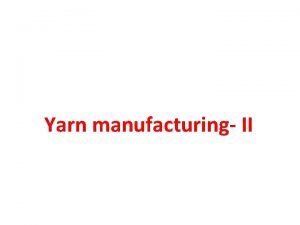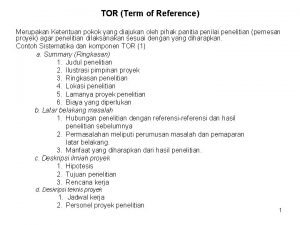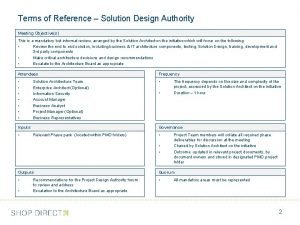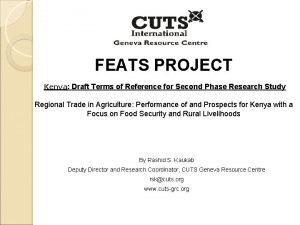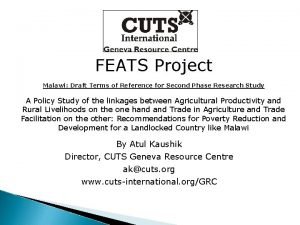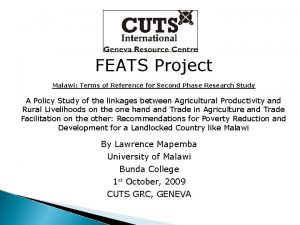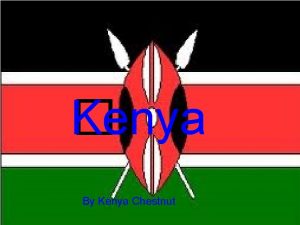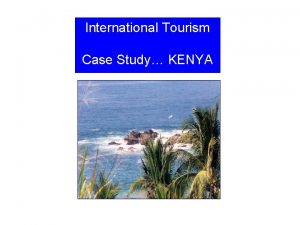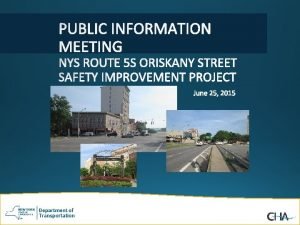FEATS PROJECT Kenya Draft Terms of Reference for













- Slides: 13

FEATS PROJECT Kenya: Draft Terms of Reference for Second Phase Research Study Regional Trade in Agriculture: Performance of and Prospects for Kenya with a Focus on Food Security and Rural Livelihoods By Rashid S. Kaukab Deputy Director and Research Coordinator, CUTS Geneva Resource Centre rsk@cuts. org www. cuts-grc. org

BACKGROUND Findings of phase one study affirm the importance of agriculture in Kenyan economy ◦ Agriculture sector contributes substantially to GDP, provides bulk of employment, foreign exchange earnings and export diversification efforts focused in agriculture ◦ Yet, rural areas have high poverty rates and substantial informal sector employment ◦ Livelihood and employment concerns must be included in development of the agricultural sector Criteria for topic ◦ Within “trade in agriculture”; important for livelihoods and employment; and an area where further research and analysis can add real value Feedback from Kenya National Reference Group ◦ Desire a topic in agriculture in the broader context of regional trade with particular emphasis on rural poverty and livelihoods, and food security ◦ This study will provide valuable insight for future actions based on the analysis of the past and current patterns of regional trade in agriculture and their impact on food security and rural livelihoods in Kenya.

STUDY OBJECTIVES To collect information on and analyse the recent trends in regional trade in agriculture, and on food security and rural livelihoods in Kenya; • To identify and quantify the volume and composition of informal trade in agriculture products between Kenya and its regional trading partners; Examine the relationship between regional trade in agriculture and food security and rural livelihoods Generate new insights and knowledge that carry practical implications To contribute to finding national and regional policies that can harness regional trade in agriculture to improve food security and rural livelihoods so as to achieve the objectives of Kenya Vision 2030

KEY SUBSTANTIVE ISSUES TO BE COVERED Kenyan participation in regional trade in agriculture including both the imports into and exports from Kenya to its regional trading partner countries; Informal regional trade in agriculture including its magnitude and composition as well as main factors determining these; Main issues and concerns related to food security and rural livelihoods in Kenya; Role and impact of multilateral (WTO) and regional agreements (EAC, COMESA as well as EPA) on volume and composition of regional trade in agriculture, and food security and rural livelihoods in Kenya; National policies related to agriculture, trade, and regional integration; Linkages and relationships among various issues with focus on identifying areas for synergetic action; and Development of a framework to leverage regional trade in agriculture to improve food security and rural livelihoods in Kenya.

METHODOLOGY Principles Pooling of knowledge and expertise on regional trade, trade in agriculture, food security, and rural livelihoods; Cross-fertilization of ideas and experiences during the study process through involvement of national and international experts; Facilitation of buy-in of the research and its findings by the relevant stakeholders in the country by involving them through KNRG and meetings etc. Plan Literature search to expand annotate research questions; Data collection, fact finding and testing of hypotheses through KNRG consultations, other meetings, on-line collaboration with national, regional and international experts and partners, and targeted surveys; Consultation with the Project Advisory Committee; Presentation of draft findings to another National Stakeholders Dialogue for validation and finalization.

DETAILED DRAFT TOR OF THE STUDY Organization of Sections v INTRODUCTION v ANALYSIS v RECOMMENDATIONS

DETAILED DRAFT TOR OF THE STUDY Introduction ◦ Brief economic, trade and social profile of agriculture sector: trend in total and main crop-wise production, agricultural exports and imports, formal and informal employment in agriculture, rural poverty, and rural livelihoods (annual time series for last ten years or so) ◦ Trends in regional trade in agriculture: volume and composition of agricultural imports into and exports from Kenya to its regional trading partners (annual time series for last ten years or so) ◦ Trends in food security and rural livelihoods: evolution and key developments in the last ten years or so ◦ Policy framework: key features of development, trade, agriculture and regional integration policies and their linkages

DETAILED DRAFT TOR OF THE STUDY Analysis A. ) Regional trade in agriculture What are the main factors that contribute to or hinder regional trade in agriculture? How much of regional agriculture trade involving Kenya is through informal means? What are the key factors that encourage such trade? What is the relationship, if any, between flows of formal and informal regional trade in agriculture involving Kenya? B. ) Food security and rural livelihoods What are the key elements of food security situation in Kenya? What are the main factors responsible for the current food security situation? What have been the key developments regarding the improvements or otherwise of rural livelihoods? How are the food security and rural livelihoods conditions related?

DETAILED DRAFT TOR OF THE STUDY Analysis (cont…) C. ) National, regional and international policy dimensions, and the role of stakeholders What are the key features of national policies related to agriculture, trade and regional integration? How do they take into account food security and rural livelihoods concerns? What is the impact of regional (e. g. , EAC, COMESA) and international (under the WTO) rights and obligations on national policies on trade, agriculture and regional integration? How do these regional and international commitments impact on food security and rural livelihoods? Who are the main domestic stakeholders in relation to policy formulation and implementation on agriculture, trade, and regional integration issues? What is the level of their respective capacities and involvement in relevant policy making and implementation? What is the role of external stakeholders, e. g. , governments of regional trading partner countries, relevant REC institutions, and international donors?

DETAILED DRAFT TOR OF THE STUDY Analysis (cont…) D. ) Synthesis of linkages • What are the existing positive and negative linkages between regional trade in agriculture one the one hand, and food security and rural livelihoods in Kenya on the other? How well are these linkages understood? How can the understanding of these linkages be improved among policy makers and relevant stakeholders? • How do the relevant policies (e. g. , related to agriculture, trade, and regional integration) take these linkages into account? What are the gaps? • What are the positive and negative impacts of regional and international commitments under the relevant trade agreements on food security and rural livelihoods in Kenya? • How can the positive linkages be strengthened and negative linkages addressed? What can be a holistic framework for comprehensive analysis and coherent responses to leverage Kenyan participation in regional trade in agriculture – both formal and informal - to improve its food security and rural livelihoods? • What are the main capacity building needs in this regard?

DETAILED DRAFT TOR OF THE STUDY Recommendations to the government Recommendations to the regional partners, e. g. , governments of regional trading partner countries, relevant REC institutions, other regional stakeholders Recommendations to the CSOs, particularly farmers and rural development organizations Recommendations to the private sector

TIMELINE Research Sept. 2009: June 2010: Sept. 2010: Advocacy Networking Detailed To. R to be finalized First draft shared with PAC and peers for review Revised draft research studies ready Oct. -Dec. 2010: Jan. – March 2011: Present draft to National Dialogues in all project countries Share research results at international conference in Geneva

Thank You. Looking Forward to Your Comments and Suggestions to Finalize the To. R.
 Objects of draw frame
Objects of draw frame Polynomial classification
Polynomial classification Like terms in algebra
Like terms in algebra Term of reference (tor)
Term of reference (tor) Design authority terms of reference
Design authority terms of reference What is term of reference
What is term of reference Terms of reference in a report
Terms of reference in a report Reference node and non reference node
Reference node and non reference node Reference node and non reference node
Reference node and non reference node Fspos
Fspos Typiska drag för en novell
Typiska drag för en novell Nationell inriktning för artificiell intelligens
Nationell inriktning för artificiell intelligens Returpilarna
Returpilarna Varför kallas perioden 1918-1939 för mellankrigstiden?
Varför kallas perioden 1918-1939 för mellankrigstiden?
